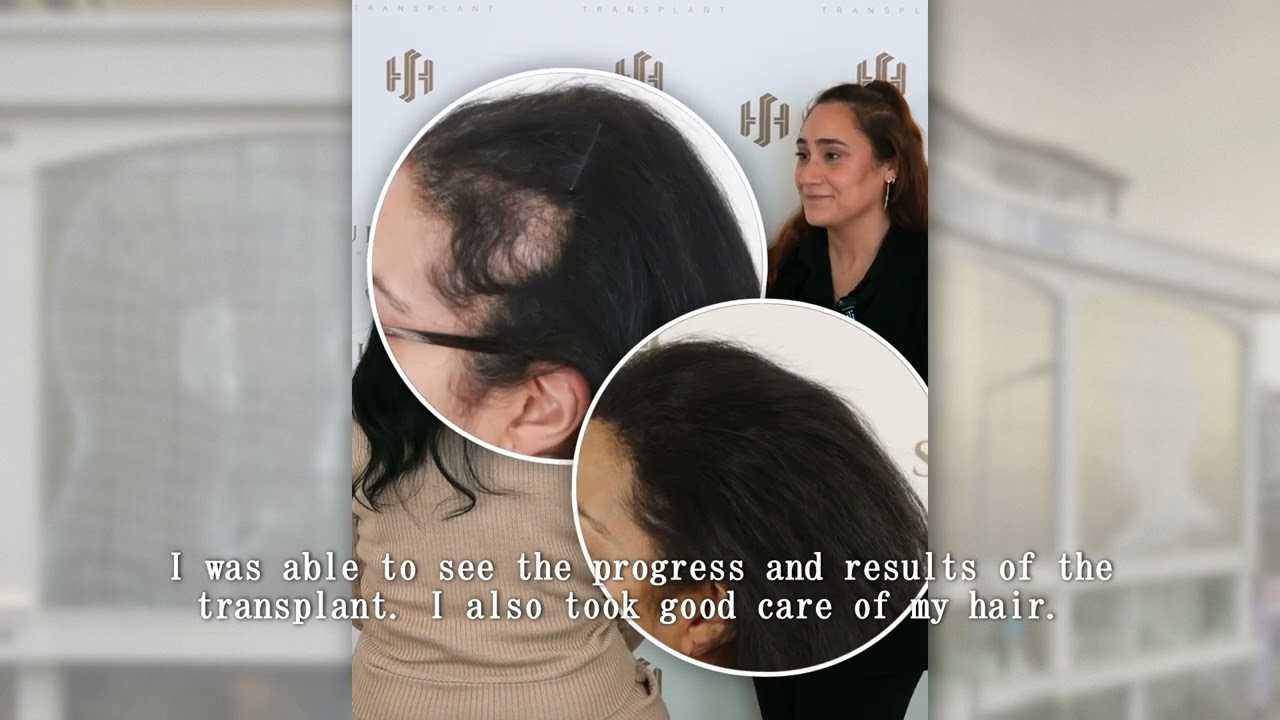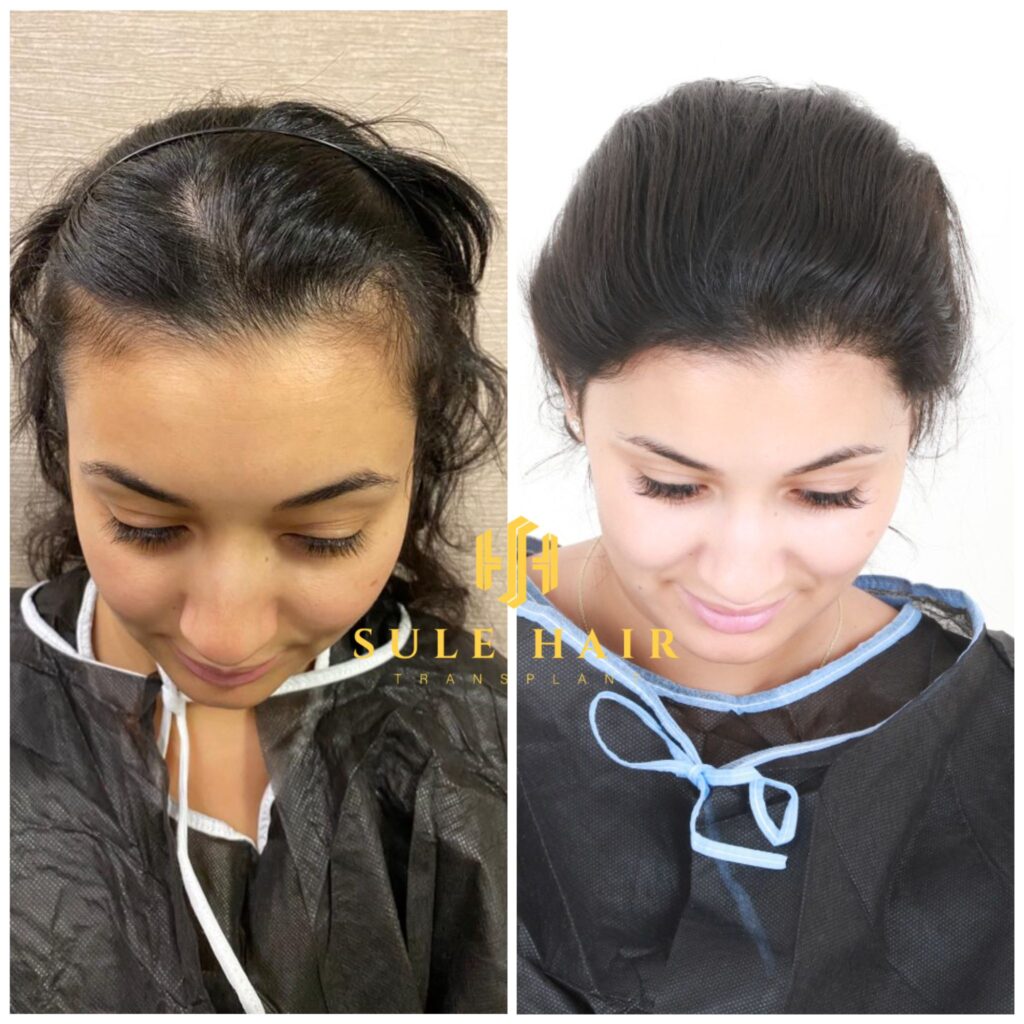
Hair loss has become a big problem for women. For women, appearance is more important than for men because hair loss adversely affects appearance and causes loss of self-confidence.
Women’s hair transplants are gaining popularity because they have a high success rate, a short recovery time, and results that look completely natural. The hair transplantation procedure, which is currently the gold standard in the industry, is utilized throughout the operation as well. Since most women would rather not shave their heads, we recommend the DHI procedure to them.
Steps in Female Hair Transplant Process
If you’re considering getting a women’s hair transplant, you probably want to know what to expect from the surgery beforehand. The procedure for a female hair transplant in Turkey can be broken down into the following steps:
- Donor regions are harvested for hair follicles (an area where hair loss does not occur and there is dense growth).
- Hair follicles are collected for removal, and then those removed follicles are grafted onto the scalp.
- The hair follicles are put where hair loss happens in a way that isn’t too invasive. This makes hair grow back in the problem areas for good.
- The hair transplant procedure for women typically takes between eight and ten hours to complete.
- The healing process is quick; when it’s completed, you’ll have very little scarring, results that seem completely natural, and almost no discomfort at all.
Once your operation is complete, you should take special care of your hair and use the aftercare products prescribed by the experts at Sule Clinic. Thankfully, an aftercare kit is included for use following surgery.
Advantages of Female Hair Transplant
- You should feel just mild soreness after the treatment.
- Nearly undetectable scarring, providing you with a hairline that looks completely natural.
- Having a full head of hair makes you feel better about yourself.
- Reduced downtime means you can return to your daily routine much more quickly.
- The risk of complications is low when compared to other types of surgery.

Women Hair Transplant: Aftercare & Recovery
Adhere to the aftercare instructions we provide after surgery. If you don’t, the hair transplant can become infected. The essentials for aftercare are outlined below.
- Because the healing period is short, there will be little disruption to your daily life after treatment.
- Swelling and pain in the operated areas are possible side effects. This is typical and shouldn’t last forever.
- To aid in the recovery process, we give each patient our aftercare kit, which details how to care for the transplanted hairs and prevent scarring.
- To aid in the recovery process, we give each patient our aftercare kit, which details how to care for the transplanted hairs and prevent scarring.
The shampoos, lotions, antibacterial serums, and medicines in your personalized aftercare kit are all made to be mild on the scalp, speeding up the recovery process. - Hair transplanted at the time of surgery will shed after three to four weeks, but will grow back within a few months.
- You should see the full effects of the surgery within a year, but after only four to six months, you should see a considerable improvement in hair growth.
Women's Hair Transplant Criteria
We carefully analyze our female patients to make sure they are good candidates for a hair transplant in Turkey at Sule Clinic. We suggest you to visit our before and after hair transplant page to see the difference after the operation. The surgeon and technicians will make a final choice based on a number of variables after your consultation, including:
Causes of Hair Loss in Women
We carefully analyze our female patients to make sure they are good candidates for a hair transplant in Turkey. The surgeon and technicians will make a final choice based on several variables after your consultation, including:
- Male-pattern hair loss
- Alopecia caused by hair pulling or traction
- Marginal balding
- Injuries (especially burns) can cause permanent hair loss.
Hair loss from stress, hormonal imbalance, vitamin deficiency, and improper hair care are all preventable causes of baldness. For some women, using heat-styling tools like straighteners, hair dryers, and curling irons might make up for the fact that their hair is weaker due to the dyeing process. We encourage you to call us to discuss your alternatives if you have experienced hair loss and suspect it is not due to any of the aforementioned problems.
Many women experience hair loss due to a deficiency, such as iron; find out about iron deficiency hair loss if you haven’t heard about it already. Low iron levels within the body can be directly linked to hair loss, but it’s difficult to 100% blame the problem on a deficiency. With a lack of iron in your body, you will experience a reduced production of hemoglobin in the blood, leading to a lack of oxygen reaching important cells. Not everybody realizes oxygen is vital for stimulating hair growth and repairing cells. If you are losing hair and feeling tired, it could be a problem with your iron levels, so get this checked before you book your female hair transplant in Turkey unless you have already lost enough hair to get a transplant. It is not only the cause of your hair loss we will consider in Turkey, but also your donor hair density.
Your Donor's Hair Density Will Be Considered
We need to examine your hair and make sure you have a donor site on your scalp before we can determine if you are a candidate for a hair transplant due to female pattern baldness. In order to perform the hair transplant, there must be sufficient hair on your scalp to cut a donor strip. We’ll take hair follicles from this location as a donor and transplant them to the bald spot. Unfortunately, you won’t be able to have the hair transplant unless you have a sufficient quantity of donor hair.
What is postpartum hair loss?
Some women experience the entirely normal but distressing phenomenon of postpartum hair loss after giving birth. If you notice hair loss immediately after giving birth due to a hormonal imbalance, it is recommended that you wait until after your child’s first birthday before worrying about it. Hair loss after giving birth is considered typical throughout this time frame. The sudden and uncontrollable loss of large amounts of hair can be distressing, but most women who have hair loss don’t go completely bald.
Can Minoxidil treat female pattern baldness?
Minoxidil is a well-known medication that can help improve female baldness and hair loss indicators. If you are experiencing female pattern hair loss, you may want to consider using this treatment. To stop women from experiencing more hair loss, a topical application of minoxidil, which comes in the form of a lotion, can be applied to the scalp. Most women will experience improvements relatively fast, and some will even see the balding completely halt. This medication is the only one that has been approved by the FDA to treat female pattern baldness. If you haven’t tried Minoxidil before, you should because the medication prolongs the phase of the hair follicles when they are actively growing hair in both women and men. Some people find that Minoxidil is not enough to address their hair loss, so they opt to get a hair transplant instead for a treatment that will be more permanent.
Female Hair Loss and Diet
There is a correlation between food and hair loss in women, particularly vitamin inadequacies and a lack of nutrients. People who have a pattern of going on extreme diets and not eating meals that are well-balanced regularly may be at a larger risk of experiencing hair loss. Furthermore, cutting calories drastically has been associated to deficiencies in protein, fatty acids, and zinc. Telogen effluvium is the name given to the type of hair loss that occurs in conjunction with shortages. Before scheduling any operations, you should examine your diet to determine whether you can prevent hair loss by dietary changes.


